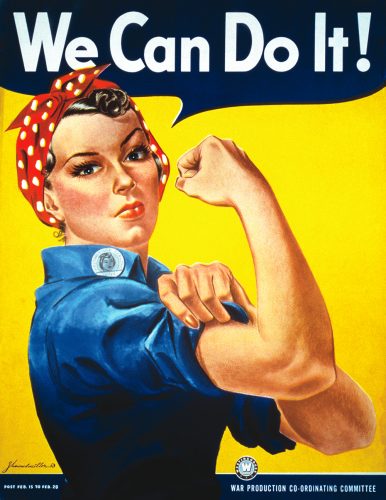SXSW: For women in journalism the future is not bleak. But there’s a lot to work on.
At a SXSW session on journalism last Saturday, panelists Sophia Jones, Jasmine Garsd Garcia, Tara Todras-Whitehill and Daniella Zalcman wanted the room to know, first and foremost, that their outlook on the representation of women and diversity in journalism was a positive one. They voiced their optimism for the industry’s direction and the work being done to be more inclusive of voices that are often left out of news narratives. The future, they said, is not bleak.
Still, they noted some bleak statistics to kick the panel off.
The mainstream news gender gap numbers paint a rather sad picture: Women make up around 37 percent of news bylines and hold a mere 27 percent of top media management positions, according to the Women’s Media Center. Even more discouraging, the panelists pointed out, is that women of color account for just 8 percent of print newsrooms.
While there is still more work to be done, Jones, Garsd Garcia, Todras-Whitehill and Zalcman offered some solutions.

Equal representation is important, not only to advance women and minorities, but to protect the value of news.
Diversity in journalism is about more than equality and hiring practices; it is an equal representation of men and women in producing the news, and an equal presence of both in the stories being read.
“Journalists tell the rest of the world what matters and how to see stories and how to look at people and places that our audiences will never visit and people they will never meet,” Zalcman said. “So, if the lens through which we are consuming politics or war or sports or entertainment or anything is exclusively white and male, that becomes very dangerous.”
Often, headlines and photos produced by men and consisting of male subjects dominate the news cycle and set the tone for what is considered to be the most valuable news. A focus on war and conflict can overshadow the more intimate perspectives and storylines that accompany those events.
“We have a concept which we’ve grown up with about what photojournalism is,” said Todras-Whitehill, commenting on the World Press Photos nominees for Photo of the Year, which mainly spotlight struggle and unrest. “Usually,” she added, “it relates to war and conflict and front line rather than the things behind which can also be, and are, the larger issues and the things that are impactful to the world.”
Recognizing that there is a problem is the first step in addressing it
Unequal representation is not a problem that will be solved overnight, the panelists noted. It will take time. To start with, it will take a conscious effort to identify gender inequality in the news when it’s present – which is not always easy to do.
As Jones noted, this problem is often seen in how stories quote women. As The New York Times pointed out in a recent article, studies show that when it comes to cited experts, women are underrepresented by ratio of three-to-one. This may be attributed to the simple reason that it’s easier to get a male source on the phone than a female, but it is up to journalists to take the extra time to seek out women who can speak to a subject with authority. SheSource tries to help solve this disparity.
“Balancing viewpoints and intersecting conversations across gender, racial and economic lines is crucial.”
Equally important, Zalcman noted, is that, in our efforts to diversify newsrooms, we must be careful not to pigeonhole reporters into covering subject areas they are representative of. Balancing viewpoints and intersecting conversations across gender, racial and economic lines is crucial if we want reporting that is cohesive, nuanced and intelligent, Zalcman said.
Mentorship is one avenue through which to increase inclusion, Garcia pointed out. By engaging with people of different backgrounds, journalists at all levels can bring more perspectives into the fold that may have otherwise gone unheard.
“That’s the first step, is that we have a problem.” Jones said. “We can move forward and create change if we just recognize it and figure out positive steps forward.”
We all must take responsibility and go about our work with intention
In order to address the issue of equal representation, journalists must take a top-down approach. On an individual level, the panel urged the women in the room to be persistent when seeking out jobs and opportunities in the field. They encouraged following up, asking for feedback, and to not be discouraged by rejection. Even more so, journalists – especially women journalists – have to empower and support one another in order to foster inclusion and a more inclusive space.
“We need our audiences to think more intentionally about the news they consume and who is creating that news,” Zalcman said. “But for us as a community, we also have to be more intentional with curation, with hiring, with publishing.”
Truth be told, that’s where the change starts – as individuals, then as a collective, communal, and systemic effort. If there is to be true success in achieving equal representation, awareness must begin on a personal level, the speakers underlined.
“Storytelling is the fabric of our society. It’s how we teach each other, it’s how we pass on information,” Zalcman concluded. “Stories matter so much and if we are not being intentional, if we are not deeply representational in how we tell stories, then we leave out voices. We leave out narratives. We start mistelling our own histories.”
- SXSW: Key takeaways on data journalism from the “news nerds” panel - March 17, 2018
- SXSW: For women in journalism the future is not bleak. But there’s a lot to work on. - March 12, 2018
- SXSW: Bernie Sanders thinks the average American is “disgusted with the current political process” - March 11, 2018





